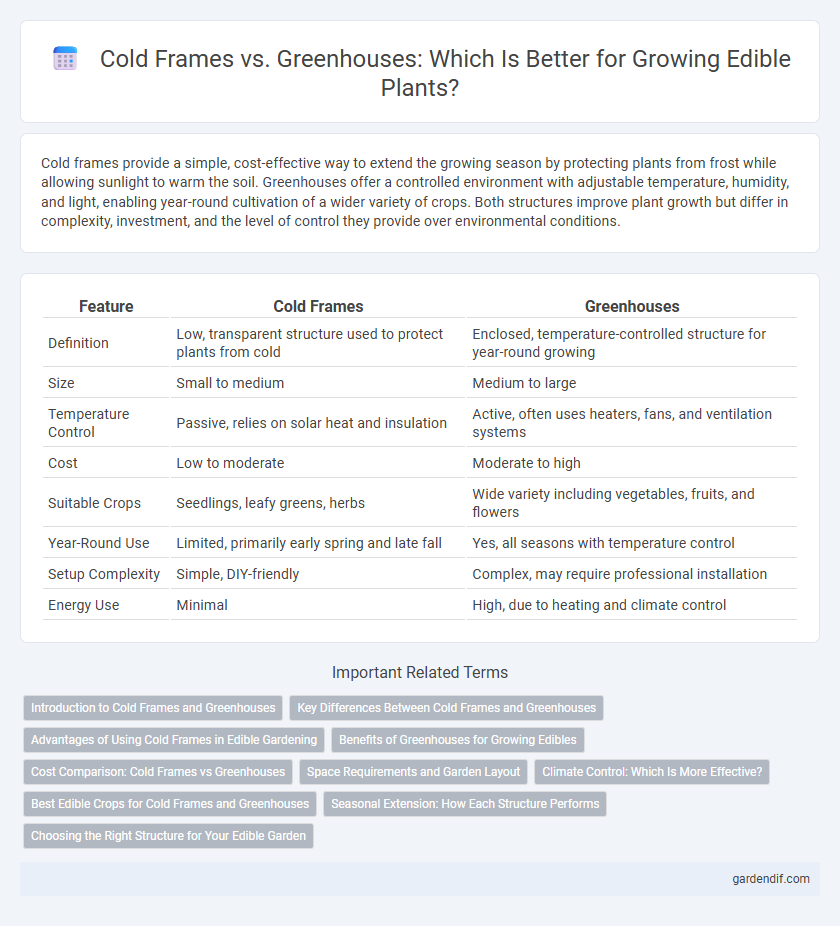
Cold frames vs Greenhouses Illustration
Cold frames provide a simple, cost-effective way to extend the growing season by protecting plants from frost while allowing sunlight to warm the soil. Greenhouses offer a controlled environment with adjustable temperature, humidity, and light, enabling year-round cultivation of a wider variety of crops. Both structures improve plant growth but differ in complexity, investment, and the level of control they provide over environmental conditions.
Table of Comparison
| Feature | Cold Frames | Greenhouses |
|---|---|---|
| Definition | Low, transparent structure used to protect plants from cold | Enclosed, temperature-controlled structure for year-round growing |
| Size | Small to medium | Medium to large |
| Temperature Control | Passive, relies on solar heat and insulation | Active, often uses heaters, fans, and ventilation systems |
| Cost | Low to moderate | Moderate to high |
| Suitable Crops | Seedlings, leafy greens, herbs | Wide variety including vegetables, fruits, and flowers |
| Year-Round Use | Limited, primarily early spring and late fall | Yes, all seasons with temperature control |
| Setup Complexity | Simple, DIY-friendly | Complex, may require professional installation |
| Energy Use | Minimal | High, due to heating and climate control |
Introduction to Cold Frames and Greenhouses
Cold frames and greenhouses both create controlled environments to extend the growing season for edible plants by trapping heat and protecting from frost. Cold frames are low, transparent structures that rely on passive solar heating, making them energy-efficient for seedlings and hardy vegetables. Greenhouses offer larger, fully enclosed spaces with advanced climate controls, enabling year-round cultivation of a wide variety of fruits, vegetables, and herbs.
Key Differences Between Cold Frames and Greenhouses
Cold frames provide a simple, low-cost solution for extending the growing season by trapping solar heat with a transparent cover, typically used to protect seedlings and young plants from frost. Greenhouses offer a controlled environment with temperature, humidity, and ventilation management, supporting year-round cultivation and a wider variety of plants. The key differences lie in scale, structural complexity, and environmental control capabilities, with greenhouses being larger and more sophisticated compared to the basic, portable design of cold frames.
Advantages of Using Cold Frames in Edible Gardening
Cold frames offer significant advantages in edible gardening, including extended growing seasons by protecting plants from frost and cold temperatures. They require less space and lower initial investment compared to traditional greenhouses, making them accessible for small-scale gardeners. Cold frames also provide a controlled microclimate that improves seedling survival rates and enhances early vegetable production.
Benefits of Greenhouses for Growing Edibles
Greenhouses offer controlled environments that enhance temperature, humidity, and light conditions, promoting faster growth and higher yields of edibles such as vegetables, fruits, and herbs. They provide year-round protection from pests, extreme weather, and seasonal changes, extending the growing season significantly compared to cold frames. The ability to regulate ventilation and irrigation within greenhouses ensures optimal plant health and maximizes nutrient absorption for more robust and productive crops.
Cost Comparison: Cold Frames vs Greenhouses
Cold frames offer a budget-friendly option for extending the growing season, typically costing between $50 and $200 depending on size and materials, while greenhouses require a more significant investment ranging from $500 to over $10,000. Maintenance and energy expenses for greenhouses can add to the overall cost, including heating, ventilation, and repairing structural components. Cold frames, made from simple wood and glass or plastic, demand minimal upkeep, making them the economical choice for gardeners seeking affordability and ease of use.
Space Requirements and Garden Layout
Cold frames require minimal space, making them ideal for small gardens or tight layouts, as they are low-profile and can be placed directly on existing garden beds. Greenhouses demand larger footprints due to their structural size, often necessitating dedicated areas with adequate sunlight and ventilation access. Efficient garden planning benefits from positioning cold frames in compact spaces or alongside other plants, while greenhouses offer versatile zones for extended growing seasons but require more deliberate spatial allocation.
Climate Control: Which Is More Effective?
Cold frames provide basic climate control by harnessing solar energy and trapping heat, making them ideal for early-season planting and frost protection. Greenhouses offer advanced climate regulation through automated systems that control temperature, humidity, and ventilation, enabling year-round cultivation of diverse crops. While cold frames are cost-effective for moderate temperature adjustments, greenhouses deliver superior precision for optimal plant growth in varying environmental conditions.
Best Edible Crops for Cold Frames and Greenhouses
Cold frames are ideal for growing leafy greens like spinach, lettuce, and arugula, as well as hardy herbs such as parsley and chives, due to their ability to protect plants from frost while maintaining moderate warmth. Greenhouses provide a controlled environment suitable for a wider range of edible crops including tomatoes, peppers, cucumbers, and strawberries, allowing extended growing seasons and improved yields. Selecting between cold frames and greenhouses depends on crop type and climate, with greenhouses offering more versatility for heat-loving vegetables and fruiting plants.
Seasonal Extension: How Each Structure Performs
Cold frames offer effective seasonal extension by protecting plants from frost and retaining soil warmth, making them ideal for early spring and late fall gardening. Greenhouses provide a more controlled environment with adjustable temperature and humidity, supporting year-round cultivation and enabling growth of a wider variety of crops. Both structures extend growing seasons, but greenhouses deliver greater climate control and versatility for prolonged edible plant production.
Choosing the Right Structure for Your Edible Garden
Cold frames provide a cost-effective, simple option for extending the growing season by protecting edible plants from frost and harsh weather while maintaining a natural outdoor environment. Greenhouses offer a controlled climate with adjustable temperature, humidity, and light, allowing year-round cultivation of a wider variety of edible crops, including delicate vegetables, herbs, and fruits. Selecting the right structure depends on factors like budget, space availability, desired crop variety, and the intensity of climate control required for optimal plant growth.
Cold frames vs Greenhouses Infographic

 gardendif.com
gardendif.com